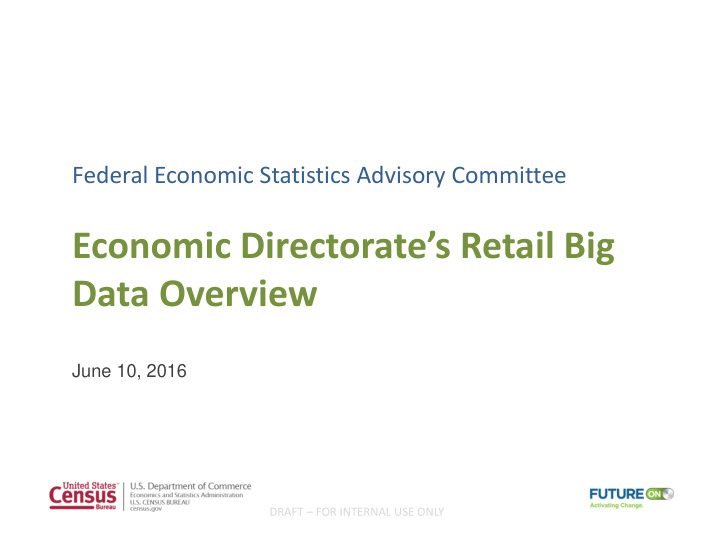



Federal Economic Statistics Advisory Committee Economic Directorate’s Retail Big Data Overview June 10, 2016 1 DRAFT – FOR INTERNAL USE ONLY
Economic Directorate Retail Big Data Projects Goal Leverage Big Data sources in conjunction with existing survey data to Provide more timely data products Offer greater insight into the nation’s economy through detailed geographic and industry-level estimates Improve efficiency and quality of processing throughout the survey life cycle 2
Economic Directorate Retail Big Data Projects Currently Active Projects Use of third-party data to add detail to Retail Trade survey data NPD Palantir/First Data Passive Data Collection 3
Economic Directorate Retail Big Data Projects NPD NPD Purchased a dataset of point-of-sales transactions from January 2012 through December 2014 Explored two datasets Auto Parts Jewelry and Watch data Obtained geographic detail at the Nielsen Designated Market Area (DMA) level 4
Economic Directorate Retail Big Data Projects NPD NPD Auto Parts and Monthly Retail Trade Survey did not display similar trends. 5
Economic Directorate Big Data Projects NPD NPD Jewelry & Watches and Monthly Retail Trade Survey did display similar trends, but not levels. Sales Indexed to January 2012 9 8 7 MRTS 6 NPD 5 4 3 2 1 0 6
Economic Directorate Big Data Projects NPD Recommendations for the use of NPD data: For geographic detail, Census needs data based on zip code, not Designated Market Area. Data sets need to be standardized to the same level of geography and detail. Product line data that align with Census Bureau product lines would be more useful than what was obtained 7
Economic Directorate Big Data Projects Palantir/First Data Collaborative short-term exploratory project involving Palantir, First Data, Bureau of Economic Analysis, and Census Bureau First Data’s consumer spending data Cover 58 billion transactions annually Capture about 45% of all point-of-sale transactions Capture credit, debit, and prepaid gift card transactions but not cash Cover five states for this pilot project Palantir’s software tool Updated daily with retail transactions Custom dashboards Environment for using R and Python 8
Economic Directorate Retail Big Data Projects Palantir/First Data Building Small Area Estimation Models Percent change in model variance over original variance for national-level model 10% Percent Change in Variance 0% ‐ 10% ‐ 20% ‐ 30% ‐ 40% ‐ 50% No Inflation Inflation x2 Inflation x5 Inflation x10 Inflation x20 Inflation x50 9
Economic Directorate Retail Big Data Projects Palantir/First Data Examining trading day weight calculations and holiday adjustments Using daily data seasonal models developed by the US Census Bureau’s Tucker McElroy and Brian Monsell Comparing daily data modeled from credit card output to current X-13 generated trading day weights and looking for areas of improvement Modeling holiday effects for Super Bowl Sunday, Chinese New Year, Easter Sunday, Ramadan, Labor Day, and Cyber Monday 10
Economic Directorate Retail Big Data Projects Palantir/First Data Daily data has revealed an Easter Sunday holiday effect Appliance, Television, and Other Electronics Store (NAICS Code 44311) ‐ 2014 11
Economic Directorate Retail Big Data Projects Passive Data Collection Goal Searching for opportunities to receive company data feeds that we can use across all of our surveys Two approaches Reaching out to companies directly Possibly partnering with a third-party source to determine if their respondents will agree to share their data with Census 12
Economic Directorate Big Data Projects Next Steps More Timely/Granular Data Products Continue to research third party data sources Complete our work with Palantir/First Data and write the summary document Review submissions to our Request for Information (RFI) to identify additional possibilities Passive Data Collection Continue searching for opportunities to receive data feeds directly from large companies that we can use across all of our surveys Research the quality of 3 rd party sources for company level data 13
Questions for the Committee In building our Fay-Herriot models, we are challenged with not having direct Monthly Retail Trade Survey estimates at a state-by- industry level. We are considering alternative inputs with known limitations; the variances associated with the alternative inputs are too small and the models are not offering as much benefit as they should. Does the Committee have any suggestions? Does the Committee have any recommendations on additional data sources for us to examine, particularly for our Retail Trade research? Does the Committee have any recommendations on the direction that we should follow in looking to reduce respondent burden – passive collection or other suggestions? Are there concerns with how we should blend official statistics and third-party data? 14
Recommend
More recommend